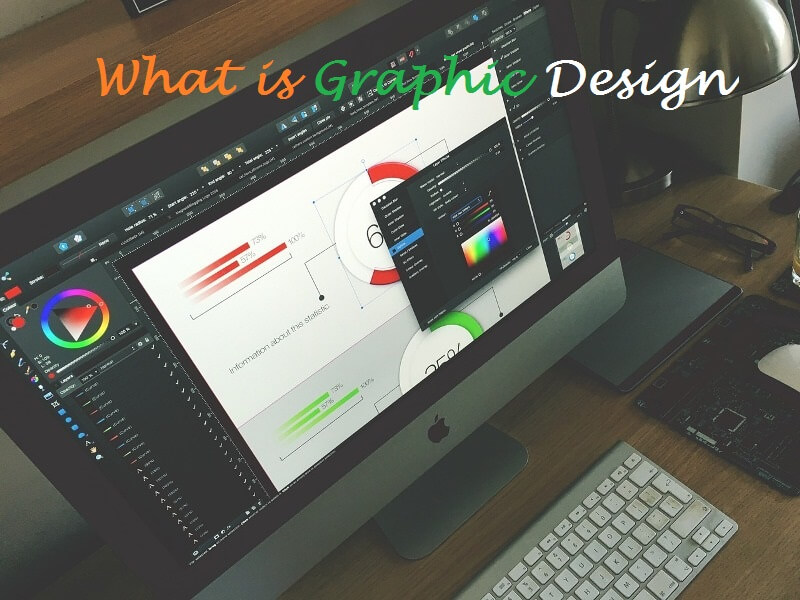What comes in your mind when you think about graphic design? Graphics for eye-catching websites? Superbly organized news covers?
There is a lot a graphic designer can do, like creating posters, infographics, book covers, product labels, logo, business cards, signs, website templates, mobile apps, software interfaces — the list goes on.
What is graphic design?
Graphic design is defined as the “art and practice of planning and projection of ideas and experiences with the visual and textual content.” Such visuals can be as plain as a company logo or as complex as website layouts.
“Graphic design takes and integrates graphical and textual elements in different media styles.” “This allows the maker to relate to the customer. It conveys a purpose, case, advertisement, or product message.
Graphic design can be used by companies to promote and sell goods via advertisements through websites by converting complex information through infographics, or by companies for, among other things like creating identity through branding.
“We take for granted many of the subtly artistic things around us every day. But a set of design ideas that influence our perceptions are hidden in every magazine corner, an exit sign, or textbook.
This is also important to note that while many graphic design projects have commercial purposes, including advertising and logos. The work of graphic design is also solely a medium for creative expression.
Graphic design Basics
To understand better the essence of graphic design, the elements, and concepts that make up design need to be understood. Elements are used together or against each other to create striking and impacting visual designs.
Such components in graphic design include:
- Color
- Form
- Line
- Cut
- Size
- Space
- Texture
Graphic designers also adhere to the design principles, which are necessary guidelines that contribute to a compelling design composition. Such basic concepts help to establish balance and stability for the work piece.
These principles of graphic design include:
- Position
- Balance
- Highlighting
- Movement
- The ratio
- Rhythm
You’ve heard the old saying that “Rules should be broken,” which could certainly be right. However, an excellent graphic designer must first understand these principles before deciding to break them consciously.
Types of graphic design
As already mentioned, there is no standard definition of graphic design. The graphic design comprises many specialist fields, from print and web design to animation and motion graphics. Graphic design offers purposes and choices for people of nearly every interest.
If you have asked someone to describe graphic design 30 years ago, your response probably would have concentrated on printed examples such as newspapers, movie posters, and advertising. We are now in the digital era, which has brought in a range of new graphic design styles.
Some of the most impressive examples of contemporary graphic design derive from technical advances. Here is an overview of some of these graphic design types:
Website design involves the creation of a user-friendly and intuitive website. It includes a general interface, color scheme, and browsing.
User experience ( UX ) design is oriented to make it enjoyable and straightforward to use a website or application. Such designers emphasize interest, accessibility, adaptability, and convenience.
Motion graphics design — or animation — through special effects, TV shows, video games, and films, offer visual elements life.
Popular graphic design tools
Now that you know what sort of jobs and specializations there are, it helps get acquainted with the visual design resources that help you accomplish your task. One of the most basic and cheapest tool designers is a sketchbook. Graphic designers often draw designs or rough sketches on paper before turning to a computer for the project to complete.
Nevertheless, even if you are designing for print, computers and design tools are essential for today’s digital world. The type of equipment you need is preferred, but Adobe products like Photoshop, Illustrator, and development are the cornerstones in the world of graphic design when it comes to software.
If you start and do not want to commit to the high-priced items that Adobe often carries, similar free open source applications like GIMP are available online.
Finally, inspiration and concepts are what a graphic designer wants. “The foundation of design and communication needs to be a solid idea.” “This definition and idea will first operate on paper and then use the machine as a device to give life to the definition.”
The world around them inspires graphic designers, so if you’re worried, you aren’t creative enough, go outside, bounce your peers’ ideas, or find internet ideas. Many inspirational graphic design blogs will help you flood your creative juices.
Is graphic designing your passion
Precisely what is graphic design? There’s no single-size definition, as you just learned. There are several ways to use graphic design to solve or inspire business problems. What graphic design means to you and your future career is up to you. Learn also tips and tricks for graphic designers
